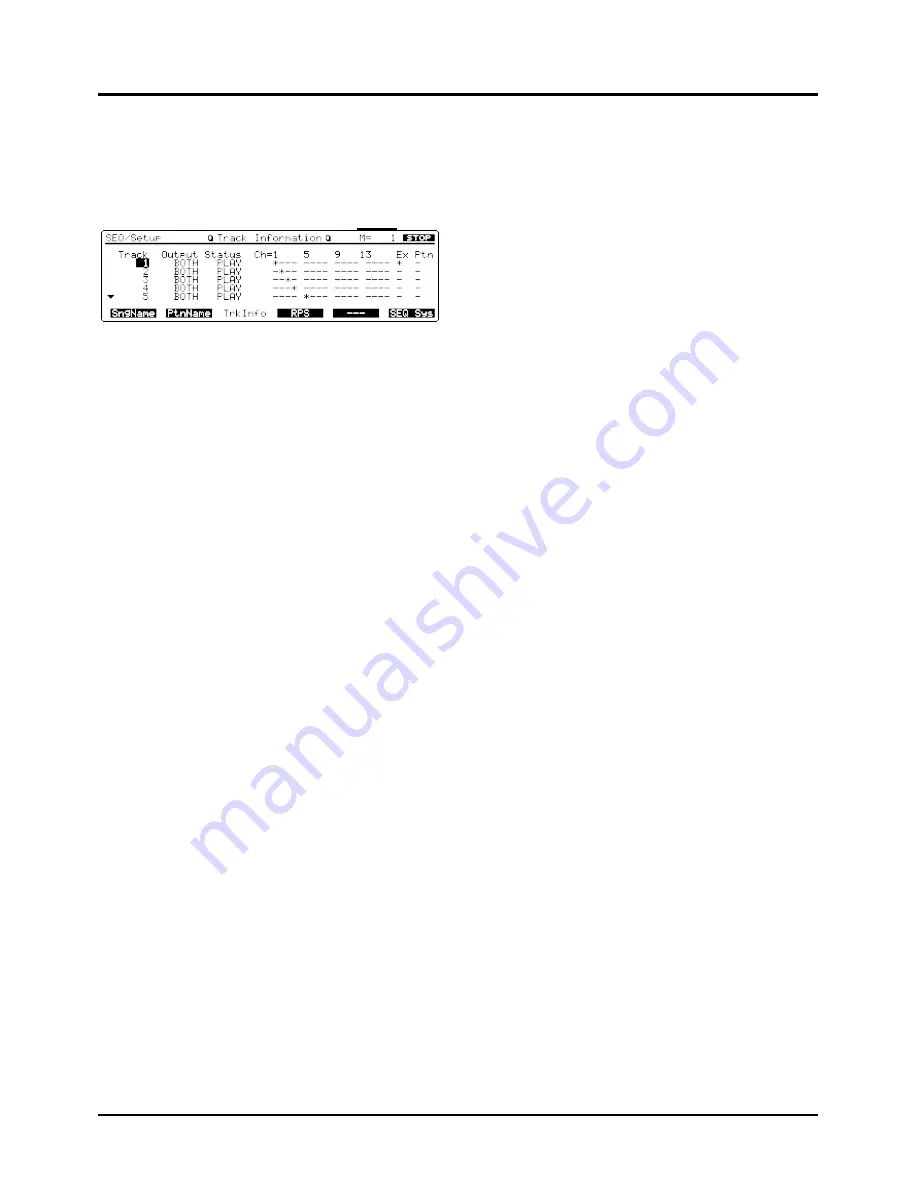
Monitoring Phrase track data and settings
You can check whether each Phrase track contains data or
not and whether it plays back or is muted, or modify assign-
ment settings. The output destination for each Phrase track’s
data can also be specified.
Output (Phrase track output assign)
Specifies the output destination of data recorded on each
Phrase track.
INT
: The data will be transmitted to the XP-80’s internal
sound source.
MIDI
: The data will be transmitted to external MIDI devices
via the MIDI OUT.
BOTH
: The data will be transmitted to both of the above des-
tinations.
Status (Phrase track status)
Specifies whether each Phrase track will play back (PLAY) or
be muted (MUTE). A Phrase track containing no data will be
indicated as “EMPTY.”
✳
Selecting PLAY or MUTE by pressing TRACK/PART
[1]–[16] on the Play display (SEQ(Song)) will also
change this setting.
✳
If the display indicates “EMPTY,” the track cannot
PLAY or MUTE.
Track Monitor
Displays the MIDI channel (Ch) on which each Phrase track
or Pattern contains data and if it contains or does not contain
any System Exclusive (Ex) or Pattern Call messages (P). A
“*” symbol indicates data exists and a “-” symbol indicates
data does not exist.
✳
“Now Playing” will appear when a song is playing
back. It is not possible to monitor a Phrase track at that
time.
<Procedure>
❶
Make sure that the Play display (SEQ(Song)) is up.
❷
Move the cursor to the song number and select the
song in which you want to monitor each Phrase track.
❸
Press [F1] (Setup).
❹
Press [F3] (TrkInfo) to call up the Track Information
display (SEQ/Setup).
✳
If you have selected a song previously saved to disk in
step 2, a window asks “This Song is not Internal Song.
Load anyway?” If you want to erase the song from the
internal memory and load the new song, press [F5]
(OK). If you decide not to erase the song from the
internal memory, press [F6] (Cancel).
❺
To change the Phrase track being displayed, press the
appropriate button from TRACK/PART [1]–[16].
To display a Pattern, press [PATTERN] and input the
Pattern number.
❻
Move the cursor to “Output” and specify the data out-
put destination.
❼
Move the cursor to “Status” and set PLAY or MUTE.
❽
Use Track Monitor to check data recorded on each
Phrase track or Pattern.
❾
After you finish making settings for each Phrase track/
Pattern and checking it, press [EXIT] to return to the
Play display (SEQ(Song)).
Locate function
Convenient Locate positions can be recorded to indicate any
position in a song or Pattern. In general, a song position is
referred to by a “measure-beat-clock” and the corresponding
time “hour:minute:second:frame” will also be displayed.
This lets you specify the same position regardless of the
locate method you use. Selecting a Locate position that has
been recorded will take you right to that position during
playback. Recording Locate positions is a convenient way to
specify a track editing area, Loop points, and an auto punch-
in recording area.
✳
The Locate function cannot be used when a song
stored on disk is selected, or the current display has no
indication of measure number or “measure-beat-
clock.”
✳
If the song’s time signature and the Pattern’s time sig-
nature (Pattern beat) differ from each other, selecting
the same Locate position will result in different posi-
tions in the song and Pattern.
✳
Refer to page 122, page 120 and page 108 for using
Locate positions to respectively specify the track edit-
ing area, Loop points, and auto punch-in recording
area.
Measure number
119
Chapter 5. Editing a song
[SEQUENCER]
➞
[F1] (Setup)
➞
[F3] (Trk Info)
Summary of Contents for XP-60
Page 245: ...245 ...






























